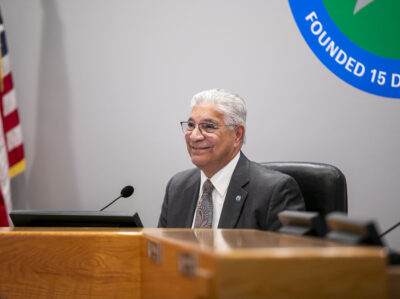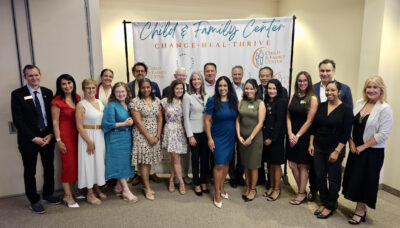Marilyn Landron, her husband and their two kids recently moved temporarily from Ventura to a Canyon Country apartment to be closer to UCLA Mattel Children’s Hospital in Los Angeles.
The family of four was forced to live in isolation and to regularly take appointments at UCLA while their newborn, Syanne, who has a compromised immune system, awaits a thymus gland.
“We’re currently on the wait list for the gland to come available,” Landron said during a recent video interview. “When the gland becomes available, we’ll get a call, and we’ll fly out.”
Landron said her daughter was born without T cells, which are a vital part of the adaptive immune system that help the body fight off infections and cancer. The thymus gland, which the family hopes to receive word about in the next six weeks to three months, is essential for the development and maturation of T cells.

When the family gets the call, they’ll jump on a plane for Duke University in Durham, North Carolina. It’s the only place, according to Landron, that can do the thymus implantation procedure. But there’s no guarantee the treatment will be successful, she said.
The family will stay at Duke for six months to a year while baby Syanne is monitored and tested to see how the gland responds.
“They can’t really determine how long it’ll take her body to regenerate T cells,” Landron said.
She and her family are from Ventura. Landron is a middle school math and science teacher at Our Lady of Guadalupe Parish School in Oxnard, though she stopped working in August just before the 2024-25 school year to be home with her daughter. Her husband, Alexander, serves in the United States Navy. The couple’s son, Dean, is 6 years old and is home schooled due to his younger sister’s condition.

Syanne was born on Aug. 21, 2024, at Community Memorial Hospital in Ventura.
“She was born at 4 in the morning, and she came in a single push,” Landron said. “She was the easiest delivery ever known in my family.”
On day 2 of Syanne’s life, she underwent a routine screening, and three days later, Landron received a call from a UCLA doctor telling her she needed to come in to talk within the next 24 hours. Her husband was in Florida for the Navy at the time. He wouldn’t be able to join her.
When Landron got to UCLA, the doctor explained that her daughter might have what’s called congenital athymia (tests would later confirm the diagnosis), a rare condition in which children are born without a thymus. Syanne had no T cells. In other words, she needed to be isolated from others to protect herself from life-threatening infections because her immune system couldn’t effectively fight off germs.

Landron would also have to isolate if she was going to be around Syanne, as she could carry germs that could harm her. Landron’s son, who was in school, stayed with his grandparents.
Landron’s husband wanted to be there. He said it was a tough time.
“It was really a helpless feeling,” he said over video chat. “Because I couldn’t be there to help them, to comfort them. Luckily, they (the Navy) let me use my paternity leave to go home and be there for a few months. But even with that, eventually I had to go back to Florida to finish my school.”
Landron built a bubble around herself and Syanne. It was a challenge. In the Ventura apartment, she had issues doing laundry because the unit didn’t have its own washer and dryer, only a shared laundry room. That wouldn’t work because she could bring germs back to the unit.

Landron’s husband eventually worked out another way to get back home from the Navy. The couple’s son also started homeschooling. They acclimated to the bubble.
In March, when they all moved to their apartment in Canyon Country to make those frequent trips to UCLA more manageable, they made sure to have their own washer and dryer.
And now that they’re in the bubble, no one can go outside, other than for hospital visits or isolated walks. They can’t go to stores. Friends and family drop off necessities for them. Landron’s husband said it’s been like an amplified version of the COVID-19 pandemic.
“I feel really bad for my son,” he said. “He’s 6 years old. Our daughter — she knows nothing else except this. But my son — he’s been outside, he has friends, he knows family. We can go for walks. We have a garage now, so I’ll take him with me to the garage and have him play. But going to a park, to a playground? No. Going to play with friends? No. Going to play with family? No.”
Eventually, when it comes time to fly to Duke for the procedure, the family won’t be able to take a commercial airline. They’ll have to take a private medical flight.
And the procedure? Landron said that comes with a $3.2 million price tag. Luckily, their insurance company, in May, approved coverage. But everything not covered has been costly.
“Financially, it’s honestly terrifying,” Landron said. “We have co-pays, we have deductibles, we have the continuous driving to and from UCLA, we have medication that’s not covered by any insurance. It’s little things that you don’t think about, and it adds up.”
In the meantime, Landron feels it’s important to share her story. When she first received Syanne’s diagnosis, she felt so alone. She desperately wanted to talk to other parents going through the same thing. She went to social media to find people who could offer hope.

“It’s silly, but when I got the diagnosis, my first thing is like, I Google it, and Google says they’ll die before age 2, which is terrifying,” she said. “I then went to TikTok to see if there were other people experiencing this who I could connect with. There was nobody. So, I was like, well, if it’s not there, I’m going to create it.”
Landron started what she called “Syanne’s Village” on TikTok, Facebook and Instagram. It’s helped her connect with others going through the same thing, and it’s also given her a way to share her story with parents who are just beginning to face it.
She talked about another mom who recently got a similar diagnosis. The mom went right to social media and found Syanne’s Village.
“We talk all the time now,” Landron said. “That’s why we created it.”
And while the Landron family’s days are filled with hospital visits, cautious routines and the quiet weight of uncertainty, they’ve found strength in the smallest things — perhaps it’s the giggle of their son echoing from the garage, the warmth of dropped-off necessities from a friend or family member, or the comfort of words from others on social media going through the same thing.
Ultimately, the family feels positive about what’s to come next. Landron’s husband is confident that there’s light at the end of the tunnel.
“We’re optimistic that she (Syanne) will get her transplant real soon,” he said. “And even after that, she still has to build up her immunity so that she can be out in the world, but we’re optimistic. We think everything will be good.”








